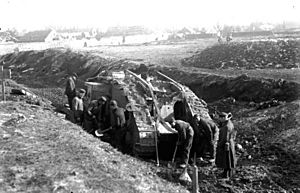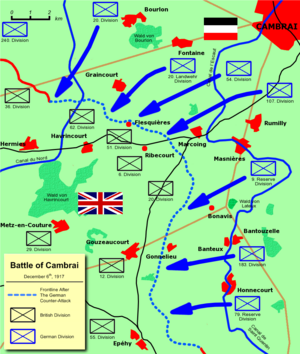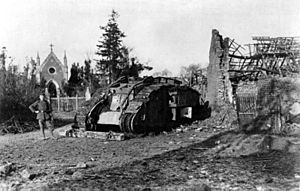Battle of Cambrai facts for kids
Quick facts for kids Battle of Cambrai (1917) |
|||||||||
|---|---|---|---|---|---|---|---|---|---|
| Part of the Western Front of the First World War | |||||||||
 German soldiers recovering a British Mark IV tank |
|||||||||
|
|||||||||
| Belligerents | |||||||||
|
|
|||||||||
| Commanders and leaders | |||||||||
| Strength | |||||||||
| 2 corps 476 tanks (378 combat tanks) |
1 corps | ||||||||
| Casualties and losses | |||||||||
| 75,681 (10,042 killed) 180 tanks |
54,720 (8,817 killed) | ||||||||
The Battle of Cambrai (Battle of Cambrai, 1917, First Battle of Cambrai and Schlacht von Cambrai) was a British attack in the First World War, followed by the biggest German counter-attack against the British Expeditionary Force (BEF) since 1914. The town of Cambrai, in the département of Nord, in France, was an important supply centre for the German Siegfriedstellung (known to the British as the Hindenburg Line) and capture of the town and the nearby Bourlon Ridge would threaten the rear of the German line to the north. Major General Henry Tudor, Commander, Royal Artillery (CRA), of the 9th (Scottish) Division, advocated the use of new artillery-infantry tactics on his sector of the front. During preparations, J. F. C. Fuller, a staff officer with the Tank Corps, looked for places to use tanks for raids. General Julian Byng, commander of the Third Army, decided to combine both plans. The French and British armies had used tanks en masse earlier in 1917, although to considerably less effect.
After a big British success on the first day, mechanical unreliability, German artillery and infantry defences exposed the frailties of the Mark IV tank. On the second day, only about half of the tanks were operational and British progress was limited. In the History of the Great War, the British official historian Wilfrid Miles and modern scholars do not place exclusive credit for the first day on tanks but discuss the concurrent evolution of artillery, infantry and tank methods. Numerous developments since 1915 matured at Cambrai, such as predicted artillery fire, sound ranging, infantry infiltration tactics, infantry-tank co-ordination and close air support. The techniques of industrial warfare continued to develop and played a vital part during the Hundred Days Offensive in 1918, along with replacement of the Mark IV tank with improved types. The rapid reinforcement and defence of Bourlon Ridge by the Germans, as well as their counter-attack, were also notable achievements, which gave the Germans hope that an offensive strategy could end the war before American mobilisation became overwhelming.
Contents
Prelude
British plan
Proposals for an operation in the Cambrai area using a large number of tanks originated from Brigadier Hugh Elles of the Tank Corps, and the reliance on the secret transfer of artillery reinforcements to be "silently registered" to gain surprise came from Henry Hugh Tudor, commander of the 9th (Scottish) infantry division artillery. In August 1917, Tudor conceived the idea of a surprise attack in the IV Corps sector, he suggested a primarily artillery-infantry attack, which would be supported by a small number of tanks, to secure a breakthrough of the German Hindenburg Line. Tudor advocated using the new sound ranging and silent registration of guns to achieve instant suppression fire and surprise. He also wanted to use tanks to clear paths through the deep barbed wire obstacles in front of German positions, while supporting the tank force with the No. 106 Fuze, designed to explode high explosive (HE) ammunition without cratering the ground to supplement the armour.
Air support
Two weeks before the start of the battle, the Royal Flying Corps (RFC) began to train its pilots in ground-attack tactics. Before the ground offensive, the RFC was assigned sets of targets to attack, including trenches, supply points and enemy airfields.
Battle
Third Army
The battle began at dawn, approximately 06:30 on 20 November, with a predicted bombardment by 1,003 guns on German defences, followed by smoke and a creeping barrage at 300 yd (270 m) ahead to cover the first advances. Despite efforts to preserve secrecy, the Germans had received sufficient intelligence to be on moderate alert: an attack on Havrincourt was anticipated, as was the use of tanks. The attacking force was six infantry divisions of the III Corps (Lieutenant-General Pulteney) on the right and IV Corps (Lieutenant-General Charles Woollcombe) on the left, supported by nine battalions of the Tank Corps with about 437 tanks. In reserve was one infantry division in IV Corps and the three divisions of the Cavalry Corps (Lieutenant-General Charles Kavanagh).
Initially, there was considerable success in most areas and it seemed as if a great victory was within reach.
The effort was aimed at Bourlon Ridge. Supported by almost 100 tanks and 430 guns, the 40th Division attacked into the woods of Bourlon Ridge on the morning of 23 November and made little progress. The Germans had put two divisions of Gruppe Arras on the ridge with another two in reserve and Gruppe Caudry was reinforced.
The 40th Division attack reached the crest of the ridge but were held there and suffered more than 4,000 casualties in three days. More British troops were pushed in to move beyond the woods but the British reserves were rapidly depleted and more German reinforcements were arriving. The final British effort was on 27 November by the 62nd Division aided by 30 tanks. Early success was soon reversed by a German counter-attack.
On 28 November, the offensive was stopped and the British troops were ordered to lay wire and dig in. The Germans were quick to concentrate their artillery on the new British positions. On 28 November, more than 16,000 shells were fired into the wood.
German 2nd Army
As the British took the ridge, German reinforcements began to arrive. By 23 November, the German command felt that a British breakthrough had been prevented and began to consider a counter-stroke and twenty divisions were assembled in the Cambrai area. The Germans planned to retake the Bourlon salient and also to attack around Havrincourt, with diversionary attacks to hold IV Corps; it was hoped to at least reach the old positions on the Hindenburg Line.
The German attack began at 7:00 a.m. on 30 November; almost immediately, the majority of III Corps divisions were heavily engaged. The German infantry advance in the south was unexpectedly swift. The commanders of the 12th (Eastern) Division and 29th Division were almost captured, with Brigadier-General Berkeley Vincent having to fight his way out of his headquarters and grab men from retreating units to try to halt the Germans. In the south, the German advance spread across 8.1 mi (13 km) and came within a few miles of the village of Metz and its link to Bourlon.
At Bourlon, the Germans suffered many casualties. British units displayed reckless determination. The concentration of British effort to hold the ridge was effective but allowed the German advance elsewhere greater opportunity. Only counter-attacks by the Guards Division, the arrival of British tanks and the fall of night allowed the line to be held. By the following day, the impetus of the German advance was lost but pressure on 3 December led to the German capture of La Vacquerie and a British withdrawal on the east bank of the St Quentin canal. The Germans had reached a line curving from Quentin Ridge to near Marcoing. On 3 December, Haig ordered a partial retreat from the north salient and by 7 December, the British gains were abandoned except for a portion of the Hindenburg line around Havrincourt, Ribécourt and Flesquières. The Germans had exchanged this territorial loss for a slightly smaller sector to the south of Welsh Ridge.
Casualties
According to the Statistics of the Military Effort of the British Empire during the Great War, British forces in the period of the Battle of Cambrai suffered 75,681 casualties, 10,042 killed or died of wounds, 48,702 wounded and 16,987 missing or prisoners of war. Nearly 180 tanks were destroyed. According to the German Army Medical report in the World War 1914–1918 German forces suffered 54,720 casualties at Cambrai, 8,817 killed and died of wounds, 22,931 wounded and 22,972 missing and prisoners of war. The British recorded casualties on the basis of a daily head count and the Germans counted the number of patients in hospital every ten days, which omitted lightly wounded, expected to return to service in a few days, not evacuated from the corps area.
Memorials and cemeteries
The Battle of Cambrai is commemorated annually by the Royal Tank Regiment on Cambrai day, a major event in the regiment's calendar. The contributions of the Newfoundland Regiment at the 1917 Battle of Cambrai are remembered in the village of Masnières at the Masnières Newfoundland Memorial. Cambrai Day is also celebrated by 2nd Lancers (GH) of the Indian Army on 1 December every year as Lance Dafadar Gobind Singh of that unit was awarded the Victoria Cross during this battle. The name Cambrai was chosen in 1917 as the new name for the South Australian town of Rhine Villa, one of many Australian place names changed from German names during the First World War. During the Remilitarization of the Rhineland in the late 1930s, Germany named a newly built Kaserne in Darmstadt after the battle, which was later merged with the nearby Freiherr von Fritsch Kaserne to become Cambrai-Fritsch Kaserne. The United States Army occupied Cambrai-Fritsch Kaserne from the end of World War II until 2008, when the land was returned to the German government.
British burial sites
The Commonwealth War Graves Commission has four Memorials with the names or remains of 9,100 Commonwealth servicemen dead during the Battle of Cambrai:
- Cambrai Memorial to the Missing - the monument lists 7,048 missing soldiers of the United Kingdom and South Africa who died and have no known graves.
- Flesquieres Hill British Cemetery - 900 servicemen were buried, one third unidentified.
- Orival Wood Cemetery - 200 servicemen buried.
- Hermies Hill British Cemetery - 1,000 servicemen buried.
German burial sites
The German War Cemetery on the Route de Solesmes was established before the offensive in May 1917, currently it accommodates the remains of 10,685 German and 501 British soldiers.
See also
 In Spanish: Batalla de Cambrai para niños
In Spanish: Batalla de Cambrai para niños





